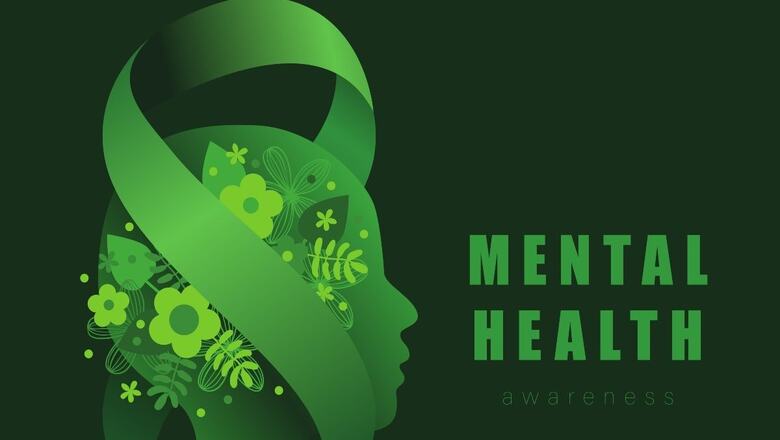
views
Galloping Mental Illnesses
In part I of the trilogy on the eve of World Mental Health Day, I began with the consensus estimate that 1 in 7 Indians are, at any point in time, suffering from one or the other mental illnesses with humungous personal, familial, social and national consequences and a growing economic cost to the economy of India that is Bharat, deflating the GDP of the country between 3-4 per cent annually.
India’s Mentally Ill
The absolute number of mentally ill in the country today ranges between “18.90 crore and 20.4 crore”. The enormity of the national burden of mental illness must be gauged from the fact that the total number of mentally ill in India is more than 2.5 per cent of the world population which translates to almost equal to Brazil’s population (seventh most populous country), double of Mexico’s population (tenth most populous country) and three times the United Kingdom’s population (21st most populous country).
It is a humungous problem statement and a frightening scenario in which the country is. Worse, the horrendous situation is worsening fast and in the absence of a comprehensive post-Covid-19 representative nationwide assessment, we have no clue of the exact number of mentally ill. And to add to the misery, India’s number of mentally ill definitely excludes the growing number of dementia patients (erudite readers to read my piece – Opinion | Alzheimer’s: The Mind Stealer).
Mental Illness Disease Burden in India
Looking from the prism of the disease burden measured in terms of disability-adjusted life years (DALY), according to the Lancet study, “The burden of mental disorders across the states of India: The Global Burden of Disease Study 1990-2017 (India State-Level Disease Burden Initiative Mental Disorders Collaborators. Lancet Psychiatry. 2020) mental illness accounted for 4.7 per cent (3.7-5.6 per cent) of total DALYs in India in 2017, compared to 2.5 per cent (2.0-3.1 per cent) in 1990. Mental illnesses have become the major cause of years of healthy life lost due to disability (YLDs) in India in 2017 accounting for 14.5 per cent of all YLDs. Depressive disorders (33.8 per cent, 29.5-38.5) and anxiety disorders (19.0 per cent, 15.9-22.4) contributed the most DALYs in India in 2017, followed by dissociative identity disorder (DID) (10.8 per cent, 6.3-15.9 per cent), schizophrenia (9.8 per cent, 7.7-12.4 per cent), bipolar disorder (6.9 per cent, 4.9-9.6 per cent), and conduct disorder (5.9 per cent, 4.9-8.1 per cent). As this is just a sample study, the real truth is scarier.
Unavailable Psychiatric Care Services
The Government of India National Mental Health Policy Group (2011-2014), of which yours truly was a member at the time of drafting the National Mental Health Policy, 2014, estimated that at least 2-3 crore severely mentally ill in the country required hospitalisation or intensive mental health care, though not all at the same time. The actual number of such cases has since grown to approximately 5 crores and is growing fast both due to the increase and severity of mental illness and the fast-growing population of the country.
Contrarily, the availability of mental health professionals and psychiatric beds in the country remains dismal. After thorough research, my own estimation for 2011 was 3,500 psychiatrists, 1,200 clinical psychologists and therapists, 600 psychiatric social workers and 300 psychiatric nurses. Also, the total number of psychiatric beds in the country in 2011 was 25,000 (as against 10,500 at independence as estimated then by the Bhore Committee) which included the beds in mental hospitals, medical colleges, district hospitals, private hospitals and NGO-run establishments.
In the absence of reliable government data, I take my own assiduously collated numbers closer to the truth. My numbers are corroborated by the World Health Organisation’s (WHO) data, according to which in 2011, there were 0·301 psychiatrists, 0·166 nurses, and 0·047 psychologists for every 100,000 patients in India.
WHO data also suggests that in India, the number of psychiatric beds per 10,000 patients in psychiatric hospitals in 2011 was 1·490, and in the general hospitals 0·823. Make no mistake, as compared to India, as per WHO data, the number of psychiatric beds per 10000 patients in other countries is – Japan (66.647), Australia (21.761) USA (11.143), UK (23.914), Poland (15.583) and Serbia (18.325). Even Tonga (24.444), Sri Lanka (3.949) and Pakistan (3.272) fare better than India.
WHO figures about the availability of mental health professionals and mental healthcare services in the country reflect the magnitude of the serious deficiency and the consequent burden and distress on account of untreated mental illness prevalent in the country. Cut to circa 2023, situations have only worsened with the galloping increase of severely mentally ill patients and an incremental increase in mental health care professionals and facilities.
Required Optimal and Minimum Psychiatric Beds
How pitiable the psychiatric facilities in the country are, is exemplified by the most recent 2022 study published in the reputed Medical Journal Nature, which for the first time has estimated the minimum and optimal numbers of psychiatric beds required using the Delphi method (for the uninitiated the Delphi method is a process used to arrive at a group opinion or decision by surveying a panel of experts).
The study carried out by a panel comprising 65 experts (42 per cent women, 54 per cent based in low- and middle-income countries) from 40 countries in the six regions of WHO has estimated that 60 psychiatric beds per 100,000 population (not patients) were considered optimal and 30 the minimum, whilst 25–30 was regarded as mild, 15–25 as moderate, and less than 15 as severe shortage. This is the first expert consensus on minimum and optimal bed numbers involving experts from HICs and LMICs. As per the study, India falls in the category of having a severe shortage.
Horrifying Accessibility of Psychiatric Medicare
Let me begin with a personal note. My cousin Shyam (name changed for privacy concern) is my age, unemployed and severely mentally ill (Schizophrenia patient) for the last 40 years and stays in my native village in Bihar. The district headquarters is 50 km away and has no psychiatrist. The nearest government mental health hospital, Kanke Ranchi in Jharkhand is 500 km where he has been hospitalised and treated infrequently without improvement, but after spending the family fortune, he has reached a dead end.
The story of Shyam is atypical of a severely mentally ill in rural India. The fate of the urban poor is the same, even worse.
Truth beckons that while the availability of psychiatric care, in terms of resources, facilities and services is pitiable, the accessibility is truly horrifying. Different studies including data from India’s first National Mental Health Survey, put the accessibility gap data between 70 to 92 per cent. Unsurprisingly then, most mentally ill in the country are incarcerated without a diagnosis.
Most horrifying is the condition of government mental hospitals. There are just 43 government mental hospitals in the country for 140 crore Indians, most of which are in pitiable conditions. And the latest estimated number of psychiatrists may have risen to 4,000-5,000 (the data is unreliable as hundreds if not thousands of registered psychiatrists have left for greener pastures abroad), most of them located in metropolitan cities, that too doing private practice at the hefty cost of Rs 1000-3000 per patient per visit, making mental health clinical therapy completely out of the reach for the rural dwellers and urban poor alike.
Worse, at any given point of time, around 25-40 per cent posts of mental health professionals are lying vacant in the government mental hospitals. The most critical shortage is of psychiatric nurses. How the world’s soon-to-be most populous country will manage without critical resources for mental health care gives me shudders and sends shivers down to the marrows.
Asylum-Based Mental Health Care
When it comes to the mental health care paradigm, India is still rooted in the early 20th-century asylum-based systems. Even though their name was changed in 1920 to mental health hospitals, most of them remain custodial care, asylums, and nothing else. Having frequently visited at least one dozen of them as a Member of the Government of India Mental Health Policy Group and as a Member of India’s first Central Mental Health Authority (CMHA) and working in one Mental Health Hospital with Tata Trust to improve it, I have no compunction in telling, with the solitary exception of three central government-run mental hospitals, most others are no better than pigs-Stys. I have seen a few asylums which have no psychiatrist and one managed by a gynaecologist and another by a pathologist.
Despite being proscribed by the Mental Health Care Act, 2017 and being made an offence punishable with prison, tonsuring of heads of female inmates in asylums despite the intervention of the Supreme Court of India and unmodified ECTs, even to children, is the most common sight in mental asylums across the country.
Road to Grave
More horrifying is the fact that depending upon the asylum 35 to 50 per cent of inmates are long-stay patients, who have no mental illness today. They are incarcerated there because their relatives, while admitting them, did not leave the forwarding address. They languish there because, in the absence of rehabilitation facilities, they will die outside. It is better that they die daily and finally die unsung in asylums. For them, asylums are the road to the grave.
NMHP and DMHP have come to Cropper
India was one of the major World Health Organisation (WHO) member countries to launch its National Mental Health Programme (NMHP) in 1982 in accordance with WHO’s recommendations to deliver mental health services to the people under the framework of a general health care system in the community. Also, the District Mental Health Program (DMHP) was launched under NMHP in the year 1996 (in IX Five Year Plan). The DMHP was based on the ‘Bellary Model’ with the following components: early detection & treatment. Both NMHP and DMHP were launched with much fanfare. India, today, has 766 districts and as per the 2023 report of the Government of India, the District Mental Health Programme (DMHP) component of the NMHP has been sanctioned for implementation in 716 districts for which support is provided to States/UTs through the National Health Mission. But the sad truth is both NMHP and DMHP, except in a few southern states, have come a cropper and failed to deliver. A fuller analysis of reasons for their failure is outside the scope of this piece, suffices to say that the key culprit is lack of intent, structural deficiency of the programmers, lack of psychiatrists to run DMHPs and the federal health care model where health and thereby mental health is state subject are the key culprits.
Right Based Mental Health Care Act has proved a non-starter
The theme of 2023 World Mental Health Day is “Mental health is a universal human right.” In 2017, both Houses of the Indian Parliament unanimously enacted world best practices Right-based Mental Health Care Act, 2017 which has tumbled at the altar of implementation. It provided mental health care services to be provided at the community level and treatment facilities right up to Primary Health Centres with free medicines and optimal health care to the poor. MHCA, 2017 has so comprehensively failed in implementation that this author, who was the Member of first Central Mental Health Authority, in sheer disgust resigned in November 2021.
From Here to Where
The two pieces of the trilogy have brought out the magnitude of mental health problems and to what extent the situation has deteriorated. The third and final piece will focus on the solution and given the enormity of the problem and the opportunity cost of not doing anything, the proposed solution is centred around the creation of a separate Mental Health Ministry at the Centre and all state governments and bringing mental health care in the Concurrent List. The cost of inaction is humungous and the benefit of purposive action is immense.
Akhileshwar Sahay is Principal Instigator of Whole Mind India Foundation (WMIF) dedicated to changing the life and times of the Mentally Ill in India and also Principal Instigator of Action Group-Mission Zero Suicide India. He was a member of Government of India’s Mental Health Policy Group and a past member of Central Mental Health Authority. Sahay has lived life with incurable mental health condition bipolar disorder. He works as President, Advisory Services of Consulting Company BARSYL. Views expressed in the above piece are personal and solely that of the author. They do not necessarily reflect News18’s views.




















Comments
0 comment